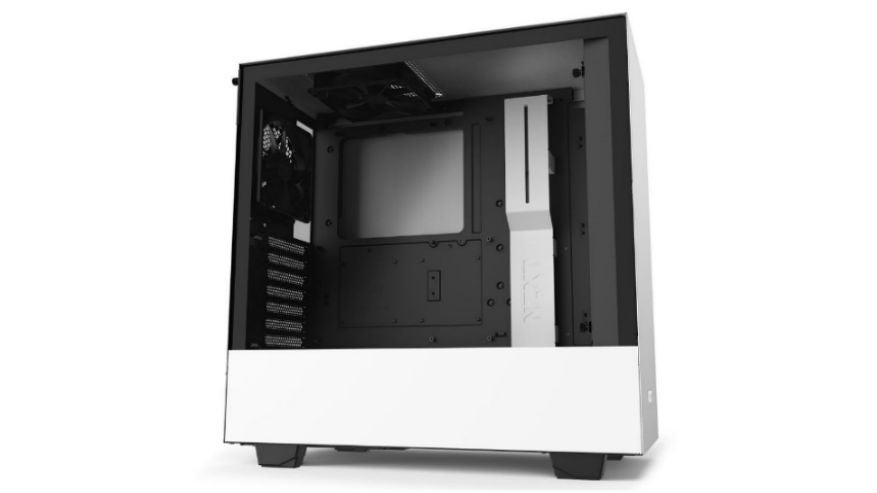To help us provide you with free impartial advice, we may earn a commission if you buy through links on our site. Learn more

- Useful features
- Clean, sharp design
- Low standard build quality
- Some design and functional flaws
To be honest, we’d hoped that NZXT’s Smart Device cases were just a phase. It wasn’t that these fan-hub-meets-RGB-controller boxes were useless, but they also didn’t do much that free desktop software couldn’t do, and their inclusion bumped up the price of every i-suffixed case that contained one. The H500, for example, was £70: a significant £30 saving on the H500i.
However, NZXT has decided it’s time for a refresh, and the Smart Device is back, as the Smart Device V2. There’s still a choice between the H510i and the non-smart H510 (both have the same launch prices as their H500 series counterparts), but only the former, on test here, has the little CAM-powered box.
NZXT H510i review: What you need to know

The V2 edition is, in fairness, improved quite significantly. It now has two RGB channels instead of just one, so you no longer have to choose between controlling the included addressable light strips or a multitude of RGB-equipped fans.
Does that make it worth the extra cash? Not really. Even if it means giving up the automated, dynamic aspect of the Smart Device V2’s approach to fan control, we’d still rather save £30 and stick to fine-tuning fan speeds or lighting colours through software.
READ NEXT: Best RAM
NZXT H510i review: Features
The only other big changes between this chassis and the H500i sit front and centre on the top I/O panel. The previous set of two USB3 ports has become one USB3 port and a USB Type-C port; a timely and welcome tweak, provided you choose a motherboard that can provide ample full-size USB connectivity on the rear panel. Less positive is the merging of the 3.5mm mic and headphone jacks into a single combo jack. This means that if you have a headset with separate mic and headphone connectors, or if you want to leave a microphone plugged in while using speakers connected to a rear port, you have to add the clutter of a splitter cable. This is, at least, bundled in.
Elsewhere, it’s all markedly similar to the H500. The dimensions are the same – a compact 460x210x428mm – while GPU clearance still sits at a respectable 381mm, with a slightly less airy CPU cooler clearance of 165mm. The stark white colour and steel construction remain unchanged too.
The good news is that you get all the H500’s best bits. One of these is the clever removable fan mounting plate for the front slots; you can take this out, screw on up to two 120mm fans, two 140mm fans or a 280mm water-cooling radiator, then reattach the plate and cooling kit with a pair of thumbscrews. It’s much easier than trying to affix multiple fans or a bulky radiator within the chassis itself.
Speaking of fans, two come pre-installed: one at the rear and one in the top, both 120mm. A front intake fan usually makes for more efficient airflow, but it’s still nice to get the extra dispersal from the top fan, when a lot of cases include only a single exhaust. Just remember that there’s not enough room to add a radiator to the top slot, although a 120mm radiator could be added to the rear fan.
NZXT H510i review: Design

For storage, there’s a decent three-bay 3.5in cage under the PSU shroud, and the topmost bay can hold a 2.5in SSD as well. There are also two dedicated 2.5in trays which can – just as brilliantly as they could on the H500 – be removed from their default position behind the motherboard and slotted just about anywhere on top of the PSU shroud. Leaving them be contributes to a cleaner look, but many might well want to display their SSDs through the tempered-glass side window.
We were quite critical of the H500’s cable management, but after seeing the same system in the H510i, that might have been a little harsh. The channels may be small and there may only be two reusable fastening straps, but on both counts that’s still preferable to the even more basic systems used by some cases. Many don’t even have defined channels, and only include little metal loops through which to thread cheap cable ties.
Sadly, the H510i also inherits some flaws, which we’re disappointed to see reappear. Metal panels both inside and out are prone to rattling and flexing, exhibiting a lower standard of build quality than NZXT has shown with the S340 Elite and the Manta. Airflow is also limited at the front, with just a strip of cut-out dots on the right side and a gap on the underside to let air in.
READ NEXT: Best gaming PC
NZXT H510i review: Verdict
The biggest issue with this case, then, isn’t an overpriced accessory hub, but a failure to improve on what was already a middling case. The H510 is closer in price to what we’d consider paying, but if you want a straightforward mid-tower with some RGB flair, the Cooler Master K500 is a better deal than both.






